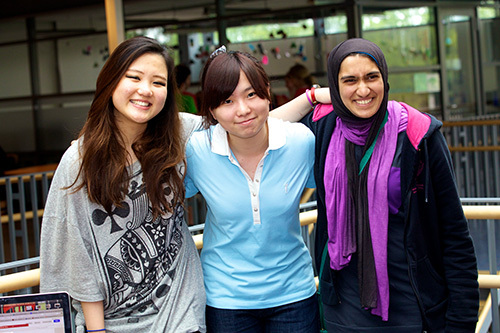
“表現不佳的學生: 他們為什麼失敗以及如何幫助他們成功” 是對以前發布的PISA數據的新分析,其中討論了影響學生的因素’ low performance on PISA together with recommendations for what countries can do to help their students.
In my interview with Andreas Schleicher, 主管教育與技能, Special Advisor on Education Policy to the Secretary-General at the Organization for Economic Co-operation and Development, we discussed the cycle of poor student performance in at-risk communities, the key characteristics of schools that affect the level of performance, how government policy can support students, and the relevance of the PISA test in a changing education environment.
安德烈亞斯: What surprised you most about the Low-Performing Students: Why They Fall Behind and How to Help Them Succeed report and why?
I was surprised how little the economic and social background of schools and countries contributes to the risk of poor performance, and how much school policy can really do about it. And you find that reflected in the progress which some of those countries that had made this a priority have achieved in reducing the share of poor performers. 例如, 巴西, 德國, 意大利, 墨西哥, 波蘭, 葡萄牙, Tunisia and Turkey significantly reduced the share of low performers in math between 2003 和 2012. What do these countries have in common? Not very much; as a group, they are about as socio-economically and culturally diverse as can be. But therein lies the lesson: all countries can improve their students’ 性能, given the right policies and the will to implement them.

How destructive is the cycle of poor student performance in at-risk communities? How does the cycle of intergenerational low-achievement affect a large country (在中美. 例如) as a whole?
Poor performance at school has long-term consequences that are hard to compensate, both for individuals and nations. Students who perform poorly at age 15 face a high risk of dropping out of school altogether. And when a large share of the population lacks basic skills, a country’s long-term economic growth is severely compromised. 事實上, 因為糟糕的教育政策和實踐的過程中損失的經濟產出使許多國家的數額是多少,經濟衰退的永久狀態 – 而另一個可以比一個是由於金融危機在千禧年之初更大更深. Think about the United States: If all 15-year-old Americans would achieve at least the most basic level of PISA performance, the US economy could gain an additional 27 trillion US$ over the working life of these students. 當然, one can always question whether it makes sense to establish global benchmarks for low performance in a highly diverse set of countries that place very different demands on the skills of individuals. But this report sets the bar at a very basic level of performance that we should expect all 21st century youths to attain. In reading, it is the threshold where students more from being able to technically read towards using reading for learning. 在數學, it involves a basic understanding of fundamental mathematical concepts and operations. And it is interesting that educational policy and practice is a much more powerful predictor for the share of students who are missing this bar than income per capita.
We also need to recognize that poor performance at age 15 is not the result of any single risk factor, but rather of a combination and accumulation of various barriers and disadvantages that affect students throughout their lives. Who is most likely to be a low performer in mathematics? 在經合組織國家平均水平, a socio-economically disadvantaged girl who lives in a single-parent family in a rural area, has an immigrant background, speaks a different language at home from the language of instruction, had not attended pre-primary school, had repeated a grade and is enrolled in a vocational track, has a 83% probability of being a low performer. While these background factors can affect all students, among low performers the combination of risk factors is much more detrimental to disadvantaged than to advantaged students. 的確, all of the demographic characteristics considered in our report, as well as the lack of pre-primary education, increase the probability of low performance by a larger margin among disadvantaged than among advantaged students, 在經合組織國家平均水平. 相反, only repeating a grade or enrollment in a vocational track has greater penalties for advantaged students. 換句話說, disadvantaged students tend not only to be encumbered with more risk factors, but those risk factors have a stronger impact on these students’ 性能.

Education Reform has become more focused on designing curricula that can best serve the trends and challenges facing our world. Given this critical big picture debate, how does the PISA test remain relevant?
That is precisely what PISA is about. The PISA test is less concerned with whether students can reproduce specific subject matter content, but more whether they can creatively use, apply and extrapolate from what they know. That’s because the modern world no longer rewards us just for what we know – Google knows everything – but for what we can do with what we know.
How important are the characteristics of schools, 包括教師, resources and student body composition, in affecting the incidence of low-performing students?
更重要, students attending schools where teachers are more supportive and have better morale are less likely to be low performers, while students whose teachers have low expectations for them and are absent more often are more likely to be low performers in mathematics, even after accounting for the socio-economic status of students and schools.
此外, in schools with larger concentrations of low performers, the quality of educational resources is lower, and the incidence of teacher shortage is higher, 在經合組織國家平均水平, even after accounting for students’ 和學校’ socio-economic status. In countries and economies where educational resources are distributed more equitably across schools, there is less incidence of low performance in mathematics, and a larger share of top performers, even when comparing school systems whose educational resources are of similar quality.
The report also shows that the degree to which advantaged and disadvantaged students attend the same school (社會包容) is more strongly related to smaller proportions of low performers in a school system than to larger proportions of top performers. These findings suggest that systems that distribute both educational resources and students more equitably across schools might benefit low performers without undermining better-performing students.

What are the key policy proposals that the OECD strongly recommends be adopted by countries with a high level of low performing students?
The first step for policy makers is to make tackling low performance a priority in their education policy agenda. Because the profile of low performers varies significantly across countries, it is essential to identify low performers and develop multi-pronged, tailored approaches. Tackling low performance requires stepping in as early as possible. That means, 除其他事項外, offering pre-primary education opportunities and remedial support in early grades. Providing schools with language and/or psycho-social support (例如. 心理學家, 導師, counsellors) for struggling students and their families, offering extracurricular activities, and training teachers to work with these students can also help. 學生, 太, can help themselves make the most of their schooling – and their own potential – by showing up at school – on time – and investing their best efforts in learning.
(All photos are courtesy of Shutterstock.com)

ç. M. 魯賓和Andreas施萊謝爾
和我一樣,全球知名的思想領袖,包括邁克爾·巴伯爵士 (英國), 博士. 邁克爾座 (美國), 博士. 萊昂特司特因 (美國), 克萊克里斯坦森教授 (美國), 博士. 琳達·達林 - 哈蒙德 (美國), 博士. MadhavChavan (印度), 邁克爾·富蘭教授 (加拿大), 霍華德·加德納教授 (美國), 安迪·哈格里夫斯教授 (美國), 伊馮娜赫爾曼教授 (荷蘭), 克里斯汀Helstad教授 (挪威), 讓·亨德里克森 (美國), 玫瑰Hipkins教授 (新西蘭), 科妮莉亞Hoogland教授 (加拿大), 這位傑夫·約翰遜 (加拿大), 太太. 尚塔爾考夫曼 (比利時), 博士. EijaKauppinen (芬蘭), 國務秘書TapioKosunen (芬蘭), 多米尼克·拉方丹教授 (比利時), 休·勞德教授 (英國), 主肯麥克唐納 (英國), 傑夫大師教授 (澳大利亞), 巴里McGaw教授 (澳大利亞), 希夫納達爾 (印度), Ř教授. 納塔拉詹 (印度), 博士. 吳PAK (新加坡), 博士. 丹尼斯教皇 (美國), 斯瑞達拉賈戈帕蘭 (印度), 博士. 黛安·拉維奇 (美國), 理查德·威爾遜·賴利 (美國), 肯·羅賓遜爵士 (英國), 帕西SAHLBERG教授 (芬蘭), 押尾佐藤教授 (日本), 安德烈亞斯·施萊歇 (PISA, 經合組織), 博士. 安東尼·塞爾頓 (英國), 博士. 大衛·謝弗 (美國), 博士. 基爾斯滕都沉浸式 (挪威), 總理斯蒂芬·SPAHN (美國), 伊夫Theze (LyceeFrancais美國), 查爾斯Ungerleider教授 (加拿大), 托尼·瓦格納教授 (美國), 大衛·沃森爵士 (英國), 迪倫Wiliam教授 (英國), 博士. 馬克沃莫爾德 (英國), 西奧Wubbels教授 (荷蘭), 邁克爾·楊教授 (英國), 和張民選教授 (中國) 因為他們探索所有國家今天面臨的大畫面的教育問題.
全球搜索教育社區頁面
ç. M. 魯賓是兩個廣為傳誦的在線系列,她接受了筆者 2011 厄普頓·辛克萊獎, “全球搜索教育” 和 “我們將如何閱讀?” 她也是三本暢銷書, 其中 真正的愛麗絲夢遊仙境, 是的發行 CMRubinWorld, 而且是干擾物基金會研究員.






最新評論